Today's feature is from Josh Lantz, Traditions Media.
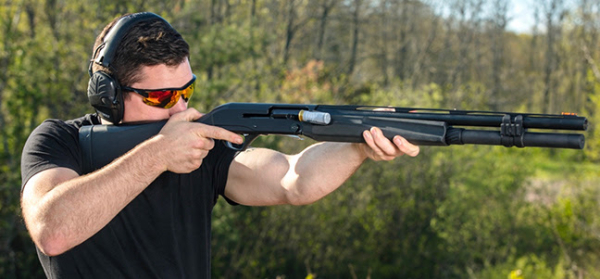
Electronic earmuffs are popular with shooting sports enthusiasts. What models are best for you?
What’s an Electronic Earmuff?
An electronic earmuff fits and seals over the ears to block sound just like passive earmuff designs. The key distinction is that they also use external microphones, internal speakers, electronic circuitry and a gain adjustment to collect and amplify ambient, low-intensity sounds like conversation, range commands and the noises made by wildlife. They also limit – or cut off – loud, potentially harmful sounds like those produced by gunfire.
Understanding NRR
Hearing protector attenuation ratings differ from region to region, and product packaging may display more than one attenuation rating. All attenuation rating numbers are given in decibels (dB) and are based on laboratory tests designed to estimate the passive noise reduction of the hearing protector. They are not designed to predict the exact amount of protection an individual user will achieve.
NRR (Noise Reduction Rating) is the standard attenuation rating used in the United States, and is also accepted for use in other parts of the Americas and some Asian countries. The U.S. Environmental Protection Agency (EPA) promulgated NRR and its labeling requirement in 1979. The EPA also specifies the standard to be used during the testing, which determines the NRR. The important thing for consumers to understand about NRR is that higher NRR numbers denote greater effectiveness. In other words, a product with a higher NRR number attenuates more noise under laboratory conditions than a product with a lower NRR number.
Depending on design and construction, electronic earmuffs generally have labeled NRR numbers between 21dB and 30dB. NRR can be applied directly to both continuous and impulse noises, so a rifle report that peaks at 156 dB can be brought down to a 135 dB peak by using properly fitted hearing protection with a 21dB NRR. The same rifle report, however, can be reduced to a peak of 126 dB using properly fitted hearing protection with a 30dB NRR. But since acoustic energy doubles every 3dB, there’s still a big difference between the two; 135dB is three times as much noise as 126dB. That’s why shooters should pay close attention to the NRR number on their hearing protection.
What and Where Are You Shooting?
Certain firearms are louder than others, and shooters should consider this fact when selecting electronic earmuffs. A firearm’s specific caliber, cartridge, barrel length and other variables will impact the amount of impulse noise it generates when fired – typically anywhere from 130dB to 160dB. The distance from the muzzle to the shooter’s ears also has an impact. Unless you want to have a buddy hold a decibel meter next to your ear while shooting and then do the math, simply keep in mind that louder guns require more protection. A high-powered rifle that produces a peak of 158dB is going to produce 600% the sound intensity of a .22 cal. rifle that produces 140dB.
The shooting environment matters, too. Indoor shooting produces a lot of reverberation, and covered outdoor shooting can be just as bad. Sound has nowhere to go in these environments, and the impact is increased intensity.
Shooters need to think about the specific firearm they are using, the environment they are using it in, and make hearing-protection decisions accordingly. The safest option is to always use the highest NRR product you can find. This is especially true when selecting electronic muffs for kids or new shooters.
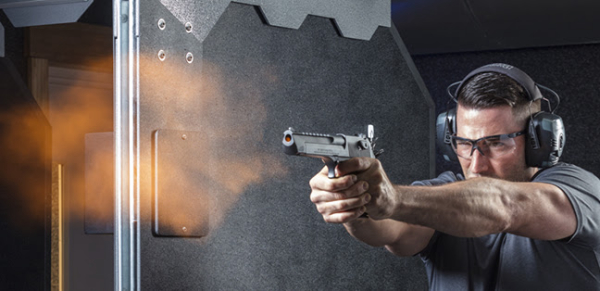
Design and Ergonomics
A wide variety of electronic earmuffs are available on the market today. They may look similar at first glance, but usually offer subtle differences in design, construction and ergonomics.
Fit is a primary consideration; the muff must seal around the ears and stay in place to provide the intended protection. Heads and ears differ in size, and ear location varies, too, so adjustability is an important consideration. Look for a muff that offers vertical adjustability of the earcups, which should be large enough in size to contain the entire ear.
For obvious reasons, comfort is another important factor. When shopping for electronic muffs, look for padding in the headband and take note of the quality and feel of the earcup cushions. Try them on before buying if you can. Make sure they are tight enough to remain in place, but don’t squeeze your head to the point where it becomes uncomfortable.
Physical size is an important consideration for shooters, too. Like passive earmuffs, an electronic muff’s ability attenuate sound is largely determined by the size – and more accurately, the volume – of its earcups. Larger earcups don’t interfere with anything when shooting pistols and some other firearms, but they can impact cheek weld and cause other challenges for some people when shooting rifles and shotguns. A variety of electronic earmuffs are available for shooters who prefer slimmer designs and low-profile earcups.
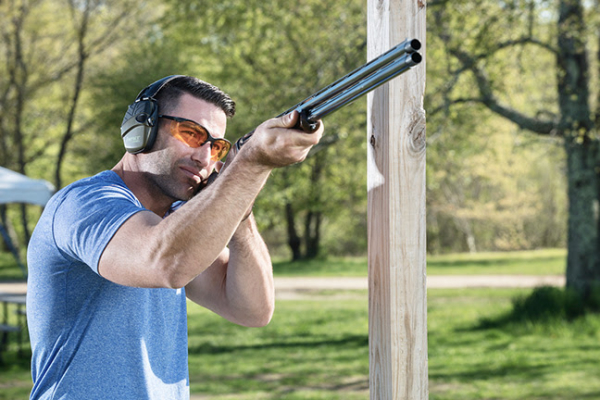
Gain and Amplification
One of the benefits of electronic earmuffs is their ability to amplify low-intensity sounds using internal speakers, external microphones and compression circuitry. This allows wearers to more easily hear range commands and conduct conversation. It’s also an important feature that allows hunters to hear nearby waterfowl or the footfalls of approaching deer or other game.
Amplification is typically controlled by a dial or knob, which wearers can turn to increase or decrease gain (the audio input signals coming through the external microphones), which has the effect of adjusting perceived volume in the internal speakers. Some electronic earmuff models have a fixed gain setting that allows wearers to hear ambient sounds at better than normal levels. Others advertise adjustable gain settings ranging from 1X to up to 5X normal sound levels. Output coming through the speakers inside the earcups of electronic earmuffs is automatically shut off whenever sound levels reach an unsafe level – regardless of amplification or gain settings.
Digital vs. Analog
All electronic earmuffs employ internal compression circuitry to momentarily cut off sound to the internal speakers when it reaches a certain, unsafe level. Some use analog circuitry and some use digital. Both have benefits.
Analog circuitry requires less power, so increased battery life is the primary benefit. Digital circuitry uses more power, so battery life is shorter than analog. Digital circuitry, however, has a faster attack time. This means digital electronic earmuffs can sense and respond to loud noises significantly faster that analog models, resulting in a more natural sound quality preferred by many.
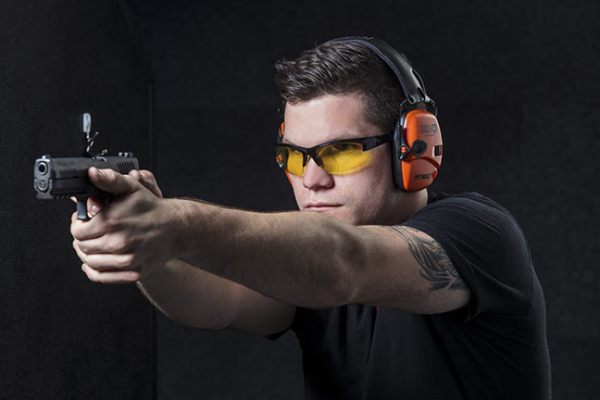
Other Features
Beyond the primary considerations already mentioned, many electronic earmuffs offer other features that broaden appeal to certain consumers.
Shooters often pack up and leave the range while forgetting to turn their muffs off. It’s a common occurrence that results in drained batteries and disappointment during the next shooting outing. Look for models with an auto shutoff feature to avoid this situation.
Speaking of batteries, they can be hard to find when needed. Consumers often purchase new electronic muffs and forget to buy batteries or don’t realize they don’t have batteries until they get to the range or into the field. Many ranges don’t sell batteries, so check the packaging when purchasing electronic earmuffs to make sure they are included. If they aren’t, buy appropriate batteries and install them right away.
Some electronic earmuffs feature an AUX input and cord, or even Bluetooth connectivity to allow wearers to listen to music or other streamed content from their mobile device. Is this important to you? If so, select electronic muffs that facilitate your desired connectivity.
Finally, shooting enthusiasts and hunters are individuals with their own sense of style and taste. This means that aesthetics can impact buying decisions. Do you want to blend into nature or stand out in the crowd? Some electronic earmuffs are available on one or two colors, while other manufacturers offer models in multiple colors and patterns.
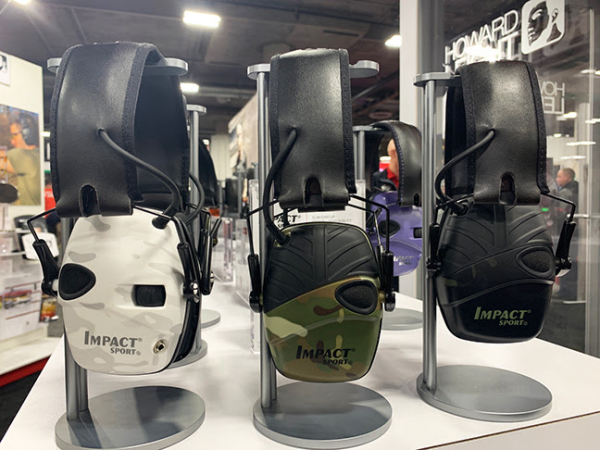
Given their multitude of benefits, electronic earmuffs continue to be one of the most popular styles of hearing protection for shooters and hunters. But they aren’t all created equal. Follow the guidelines outlined herein, and choose the muff or muffs that work best for you.
- - Josh Lantz